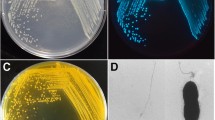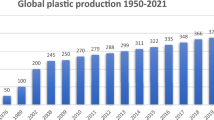Abstract
The level of lysozyme in fat body, hemocytes and cell-free hemolymph from Galleria mellonella larvae infected with Pseudomonas aeruginosa was determined and evaluated. In the samples of fat body and hemocytes, an increase in lysozyme content was detected 1 d after infection and then a significant decrease was observed after a prolonged infection time. In the case of cell-free hemolymph, an increase in the lysozyme level was noticeable during the first 30 h post injection and stayed at a similar level for 42 h. The smaller decrease of the lysozyme level after 42 h might be associated with the development of bacteremia of P. aeruginosa in insects. In addition, the gradual increase in the content of lysozyme correlated with the increase of its activity in the hemolymph of the infected larvae as a response to injection with P. aeruginosa. The G. mellonella lysozyme appeared to be insensitive to extracellular proteinases produced in vivo by P. aeruginosa.
Similar content being viewed by others
Abbreviations
- BSA:
-
bovine serum albumin
- CFH:
-
cell-free hemolymph
- CHAPS:
-
3-[(3-cholamidopropyl)dimethylammonio]-1-propanesulfonate
- DTT:
-
1,4-dithiothreitol
- EDTA:
-
ethylenediamine-N,N,N′,N′-tetraacetic acid
- EWL:
-
egg-white lysozyme
- IEF:
-
isoelectric focusing
- IPG:
-
immobilized pH gradient
- IPS:
-
insect physiological saline
- LPS:
-
lipopolysaccharide
- PMSF:
-
phenylmethanesulfonyl fluoride
- PTU:
-
N-phenylthiourea
- SDS-PAGE:
-
sodium dodecyl sulfate-polyacrylamide gel electrophoresis
References
Andrejko M., Cytrynska M., Jakubowicz T.: Apolipophorin III is a substrate for protease IV from Pseudomonas aeruginosa. FEMS Microbiol.Lett. 243, 331–337 (2005).
Andrejko M., Mizerska-Dudka M., Jakubowicz T.: Changes in Galeria mellonella apolipophorin III level during Pseudomonas aeruginosa infection. J.Invertebr.Pathol. 97, 14–19 (2008).
Araújo C.A.C., Waniek P.J., Stock P., Mayer C., Jansen A.M., Schaub G.A.: Sequence characterization and expression patterns of defensin and lysozyme encoding genes from the gut of the reduviid bug Triatoma brasiliensis. Insect Biochem.Mol.Biol. 36, 547–560 (2006).
Boman H.G., Nilsson-Faye I., Paul K., Rasmuson T. Jr.: Insect immunity. I. Characteristic of an inducible cell-free antibacterial reaction in hemolymph of Samia cynthia pupae. Infect.Immun. 10, 136–145 (1974).
Bradford M.M.: A rapid and sensitive method for quantitation of microgram quantities of protein utilizing the principle of protein—dye binding. Anal.Biochem. 72, 248–254 (1976).
Bulet P., Hetru C., Dimarcq J.-L., Hoffmann D.: Antimicrobial peptides in insect; structure and function. Develop.Comp.Immunol. 23, 329–344 (1999).
Caballero A.R., Moreau J.M., Engel L.S., Marquart M.E., Hill J.M., O’Callaghan R.J.: Pseudomonas aeruginosa protease IV enzyme assays and comparison to other Pseudomonas proteases. Anal.Biochem. 290, 330–337 (2001).
Chadwick J.S.: Relation of lysozyme concentration to acquired immunity against Pseudomonas aeruginosa in Galleria mellonella. J.Invertebr.Pathol. 15, 455–456 (1970).
Dunn P.E., Dai W., Kanost M.R., Geng C.: Soluble peptidoglycan fragments stimulate antibacterial protein synthesis by fat body from larvae of Manduca sexta. Develop.Comp.Immunol. 9, 559–568 (1985).
Dunphy G., Morton D., Kropinski A., Chadwick J.: Pathogenicity of lipopolysaccharide mutants of Pseudomonas aeruginosa for larvae of Galeria mellonella: bacterial properties associated with virulence. J.Invert.Pathol. 47, 48–55 (1986).
Engel L.S., Hill J.M., Caballero A.R., Green L.C., O’Callaghan R.J.: Protease IV, a unique extracellular protease and virulence factor from Pseudomonas aeruginosa. J.Biol.Chem. 273, 16792–16797 (1998a).
Engel L.S., Hill J.M., Moreau J.M., Green L.C., Hobden J.A., O’Callaghan R.J.: Pseudomonas aeruginosa protease IV produces corneal damage and contributes to bacterial virulence. Invest.Ophthalmol.Vis.Sci. 39, 662–665 (1998b).
Hendrickson E.L., Plotnikova J., Mahajan-Miklos S., Rahme L.G., Ausubel F.M.: Differential roles of the Pseudomonas aeruginosa PA14 rpoN gene in pathogenicity in plants, nematodes, insects and mice. J.Bacteriol. 183, 7126–7134 (2001).
Hoffman J.A., Reichert J.M., Hetru C.: Innate immunity in higher insects. Curr.Opin.Immunol. 8, 8–13 (1996).
Hoštacká A., Čižnár I., Slobodníková L., Kotulová D.: Clinical Pseudomonas aeruginosa: potential factors of pathogenicity and resistance to antimicrobials. Folia Microbiol. 51, 633–638 (2006).
Hultmark D.: Insect lysozymes. Experientia Suppl. 75, 87–102 (1996).
Jander G., Rahme L.G., Ausubel F.M.: Positive correlation between virulence of Pseudomonas aeruginosa mutants in mice and insects. J.Bacteriol. 182, 3843–3845 (2000).
Jarosz J.: Hemolymph immune proteins protect the insect body cavity from invading bacteria. Comp.Biochem.Physiol. 111, 213–220 (1995).
Jiravanichpaisal P., Lee B.L., Soderhall K.: Cell-mediated immunity in arthropods: hematopoiesis, coagulation, melanization and opsonization. Immunobiology 211, 213–236 (2006).
Jolles P., Jolles J.: What’s new in lysozyme research? Always a model system, today as yesterday. Mol.Cell.Biochem. 63, 165–189 (1984).
Kanost M.R., Dai W., Dunn P.E.: Peptidoglycan fragments elicit antibacterial protein synthesis in larvae of Manduca sexta. Arch. Insect Biochem.Physiol. 8, 147–164 (1988).
Kanost M.R., Kawoya J.K., Law J.H., Ryan R.O., Van Heusden M.C., Ziegler R.: Insect hemolymph proteins. Adv.Insect Physiol. 22, 299–396 (1990).
Kavanagh K., Reeves E.P.: Exploiting the potential of insects for in vivo pathogenicity testing of microbial pathogens. FEMS Microbiol.Rev. 28, 101–112 (2004).
Kipnis E., Sawa T., Wiener-Kronish J.: Targeting mechanisms of Pseudomonas aeruginosa pathogenesis. Med.Maladies Infect. 36, 78–91 (2006).
Laemmli U.K.: Cleavage of structural proteins during the assembly of the head of bacteriophage T4. Nature 227, 680–685 (1970).
Lavine M.D., Strand M.R.: Insect hemocytes and their role in immunity. Insect.Biochem.Mol.Biol. 32, 1295–1309 (2002).
Lazdunski A., Guzzo J., Filloux A., Bally M., Murgier M.: Secretion of extracellular proteins by Pseudomonas aeruginosa. Biochimie 72, 147–156 (1990).
Lockey T.D., Ourth D.D.: Purification and characterization of lysozyme from hemolymph of Heliothis virescens larvae. Biochem. Biophys.Res.Commun. 220, 502–508 (1996).
Lyczak J.B., Cannon C.L., Pier G.B.: Establishment of Pseudomonas aeruginosa infection: lessons from a versatile opportunist. Microbes Infect. 2, 1051–1060 (2000).
Malloy J.L., Veldhuizen R.A.W., Thibodeaux B.A., O’Callaghan R.J., Wright J.R.: Pseudomonas aeruginosa protease IV degrades surfactant proteins and inhibits surfactant host defense and biophysical functions. Am.J.Physiol.Lung Cell Mol.Physiol. 288, 409–418 (2005).
Miyata S., Casey M., Frank D.W., Ausubel F.M., Drenkard E.: Use of the Galleria mellonella caterpillar as a model host to study the role of the type III secretion system in Pseudomonas aeruginosa pathogenesis. Infect.Immun. 71, 2404–2413 (2003).
Mohrig W., Messner B.: Lysozyme as antibacterial agent in honey and bees venom. Acta Biol.Med.Ger. 21, 85–95 (1968).
Morishima I., Yamada K., Ueno T.: Bacterial peptidoglycan as elicitor of antibacterial protein synthesis in larvae of silkworm, Bombyx mori. Insect Biochem.Mol.Biol. 22, 363–367 (1992).
Morishima I., Horiba T., Iketani M., Nishioka E., Yamano Y.: Parallel induction of cecropin and lysozyme in larvae of the silkworm, Bombyx mori. Develop.Comp.Immunol. 19, 357–363 (1995).
Powning R.F., Davidson W.J.: Studies on insect bacteriolytic enzymes — I. Lysozyme in hemolymph of Galleria mellonella and Bombyx mori. Comp.Biochem.Physiol. 45, 669–681 (1973).
Salzet M.: Vertebrate innate immunity resembles a mosaic of invertebrate immune responses. Trends Immunol. 22, 285–288 (2001).
Scully L.R., Bidochka M.J.: Developing insect models for the study of current and emerging human pathogens. FEMS Microbiol. Lett. 263, 1–9 (2006).
Traidej M., Marquart M.E., Caballero A.R., Thibodeaux B.A., O’Callaghan R.J.: Identification of the active site residues of Pseudomonas aeruginosa protease IV. J.Biol.Chem. 278, 2549–2553 (2003).
Vilcinskas A., Matha V.: Antimycotic activity of lysozyme and its contribution to antifungal humoral defense reactions in Galleria mellonella. Anim.Biol. 6, 19–29 (1997).
Wang S., Ng T.B., Chen T., Lin D., Wu J., Rao P., Ye X.: First report of a novel plant lysozyme with both antifungal and antibacterial activities. Biochem.Biophys.Res.Commun. 37, 820–827 (2005).
Weise C.: UniProtKB/Swiss-Prot entry, LYS_GALME, accession no. P82174 — Lysozyme (EC 3.2.1.17, 1,4-β-N-acetylmuramidase) (2001); http://expasy.org/uniprot/P82174.
Yu K.H., Kim K.N., Lee J.H., Lee H.S., Kim S.H., Cho K.Y., Nam M.H., Lee I.H.: Comparative study on characteristics of lysozymes from the hemolymph of three lepidopteran larvae, Galeria mellonella, Bombyx mori, Agrius convolvuli. Develop.Comp. Immunol. 26, 707–713 (2002).
Author information
Authors and Affiliations
Corresponding author
Rights and permissions
About this article
Cite this article
Andrejko, M., Mizerska-Dudka, M. & Jakubowicz, T. Changes in Galleria mellonella lysozyme level and activity during Pseudomonas aeruginosa infection. Folia Microbiol 53, 147–151 (2008). https://doi.org/10.1007/s12223-008-0021-2
Received:
Revised:
Published:
Issue Date:
DOI: https://doi.org/10.1007/s12223-008-0021-2




